I'll never forget the first time I tasted Pinangat ng Bicol during a weekend visit to my college roommate's home in Naga City. Her Lola insisted I try her specialty, and as she untied the banana string from the taro leaf parcel, the aromatic steam that escaped was unlike anything I'd experienced.
The delicate balance of fresh shrimp and young coconut meat, wrapped in tender taro leaves and simmered in rich coconut milk, was a revelation that showed me just how sophisticated Bicolano cuisine could be.
This treasured recipe has become my go-to dish for special occasions, never failing to impress my Manila friends who are used to the usual adobo and sinigang.
While it might look intimidating at first, I've simplified my Bicolana friend's family recipe to make it accessible for home cooks while keeping all the authentic flavors intact.
Once you master this Pinangat recipe, you'll understand why Bicolanos are so proud of their culinary heritage, and why this dish deserves a spot in your regular Filipino recipe rotation.
Important Reminder: Taro leaves must be fresh, never wilted or old, for food safety
Jump to:
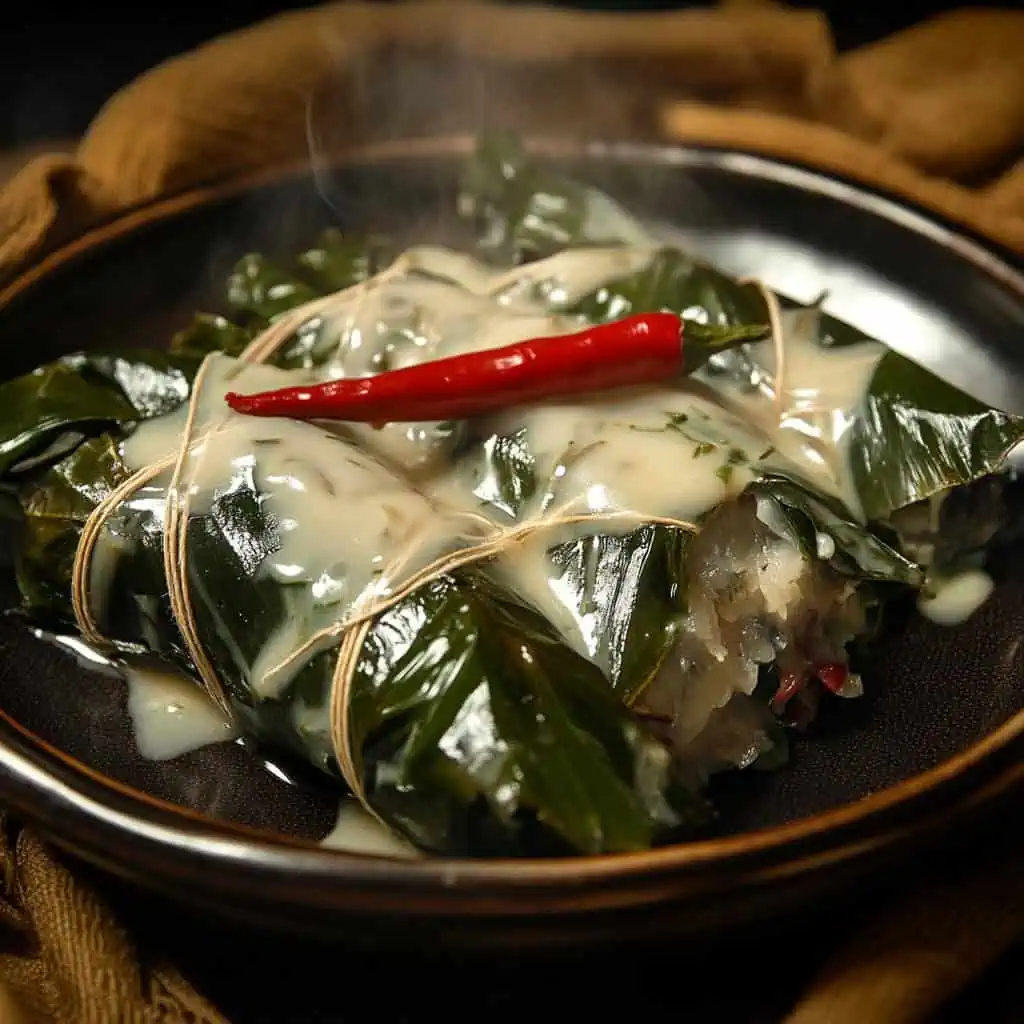
Why You'll Love This Recipe
- Authentic flavors that showcase Bicol's culinary heritage
- Perfect balance of seafood and coconut
- Healthy ingredients with natural flavors
- Impressive presentation for special occasions
- Can be made ahead for gatherings
- Rich in protein and nutrients
Ingredients
Each ingredient in Pinangat serves a purpose in creating its distinctive flavor profile. Fresh shrimp provides a sweet, delicate seafood base, while young coconut adds natural sweetness and texture.
Taro leaves aren't just wrappers, they become silky and flavorful when cooked. Aromatics like lemongrass, garlic, ginger, and chilies add layers of complexity, while coconut milk and cream create the rich, velvety sauce that Bicolano cuisine is famous for.
This thoughtful combination celebrates the natural abundance of coastal Bicol, where seafood and coconut trees thrive in volcanic soil.
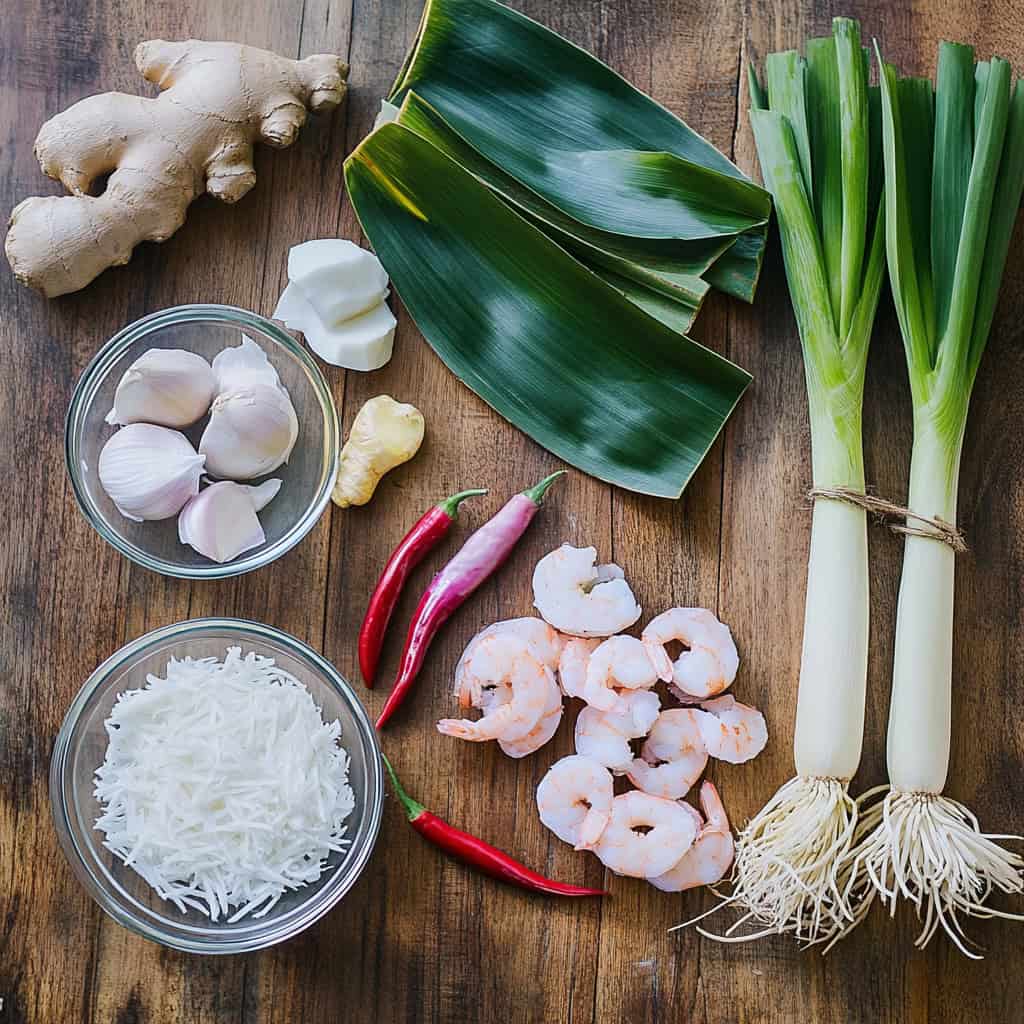
For the Filling:
- ½ kg freshwater shrimp (hipon), peeled and seasoned with 1½ tablespoon salt
- 600 g young coconut meat (buko), about 5 young coconuts, grated
- 2 onions (sibuyas), chopped
- 2 tablespoon grated ginger (luya)
- 6 cloves garlic (bawang), minced
- Chilies (siling labuyo) to taste, finely chopped
- 20-30 fresh taro leaves (dahon ng gabi) - must be intact without holes
- Kitchen string for tying
- 6-8 stalks lemongrass (tanglad), white portions only, smashed
- 3-4 cups pure coconut milk (gata)
For the Sauce/Topping:
- 2 cups thick coconut cream (kakang gata)
- 5 cloves garlic (bawang), finely chopped
- 4 shallots (sibuyas tagalog), finely chopped
- 2 stalks lemongrass (tanglad), white portions sliced
- Salt (asin) to taste
- 3-5 spring onions (dahon ng sibuyas), finely chopped
Equipment
- Large pot with lid (kaldero) - Essential for properly steaming the Pinangat parcels; a heavy-bottomed pot distributes heat evenly and prevents burning
- Food processor or large knife (panggilingan) - For efficiently mixing the filling ingredients to the proper texture
- Kitchen twine (pisi) - For securely tying the leaf parcels to prevent filling from leaking during cooking
- Heavy-bottom cooking pot (makapal na kaldero) - Provides even heat distribution when simmering the coconut sauce
- Measuring cups and spoons (panukat) - Ensures accurate proportions of ingredients for consistent results
- Chopping board (sangkalan) - Provides a clean, stable surface for preparing ingredients
- Sharp knife (matulis na kutsilyo) - For precise cutting of herbs and aromatics
- Grater (kudkuran) - Used for preparing the young coconut meat to the perfect consistency
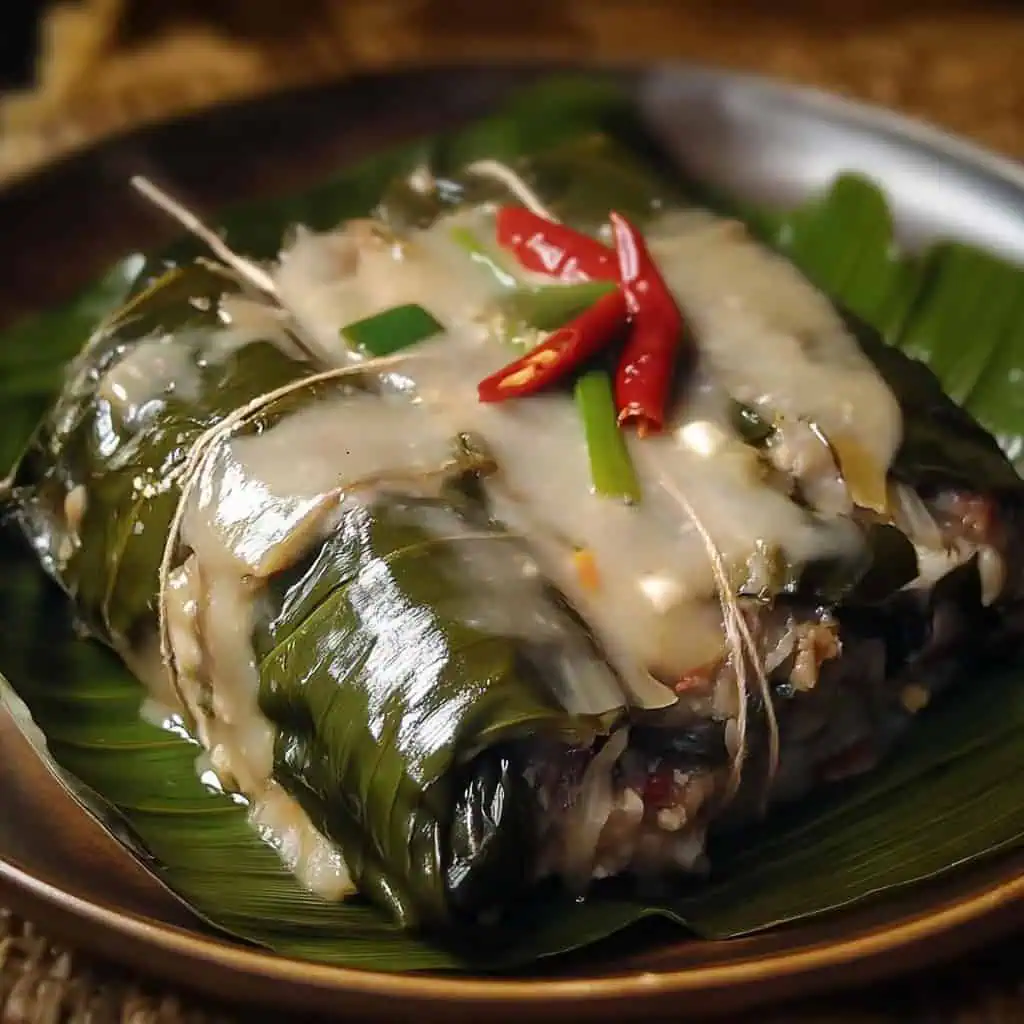
How To Make
- Prepare the filling: Using a food processor or large knife, combine the peeled and salted freshwater shrimp, grated young coconut meat, chopped onions, grated ginger, garlic, and chilies until the mixture has a cornmeal-like texture. Keep this mixture at room temperature while preparing the leaves.
- Prepare the leaf parcels: Carefully inspect fresh taro leaves to ensure they have no holes or spots, as these can cause leaks during cooking. Lay out overlapping taro leaves in your work area. Place approximately 3 tablespoons of the prepared filling mixture in the center of the leaves. Wrap the leaves carefully around the filling, making sure to seal the edges well, and tie securely with kitchen string or use the taro leaf stalks as natural ties.
- Cook the Pinangat: Before cooking, prepare your pot by lining the bottom with smashed lemongrass stalks. Arrange the wrapped Pinangat packets carefully in the pot, then pour in 3-4 cups of pure coconut milk until the packets are mostly covered. Bring to a gentle simmer over low heat (160°F/71°C), cover the pot, and cook for 45-60 minutes, occasionally shaking the pot gently to prevent sticking. The Pinangat is done when the leaves are soft and most of the coconut milk has been absorbed.
- Prepare the sauce: While the Pinangat is cooking, prepare the sauce. In a separate pan over medium-low heat (175°F/79°C), combine 2 cups of thick coconut cream with finely chopped garlic, shallots, and sliced lemongrass. Simmer until the sauce becomes thick and creamy, then season with salt to taste. Just before removing from heat, stir in finely chopped spring onions.
- Serve: Serve the Pinangat hot with steamed white rice, generously spooning the prepared sauce over each portion.

Tips from Lola's Kitchen
- Select the right leaves: Choose young taro leaves that are bright green and pliable for better wrapping and texture. Older leaves can be tougher and more bitter.
- Freshness test: Inspect each leaf carefully - if you can see light through any tiny holes when held up, set that leaf aside as it will leak during cooking.
- Fresh coconut is best: For authentic flavor, extract coconut cream from fresh mature coconuts rather than using canned alternatives.
- Enhance the coconut flavor: Lightly toast the grated young coconut meat in a dry pan for 2-3 minutes before mixing it with other ingredients for deeper flavor.
- Natural ties: Use strips of banana leaf instead of kitchen twine for a more traditional approach and subtle flavor enhancement.
- Gentle cooking: Never let the coconut milk boil vigorously; a gentle simmer is key to prevent curdling and bitter flavors.
- Let it rest: Allow the Pinangat to rest for 10 minutes after cooking for the flavors to further develop before serving.
- Season gradually: Add salt gradually to both the filling and sauce, tasting as you go to achieve the perfect balance.
Substitutions
- Fresh shrimp: Can be replaced with dried shrimp (hibe) for a more intense flavor, or crab meat for a different seafood profile.
- Taro leaves: In an absolute emergency, banana leaves can be used, but the flavor and texture will be significantly different.
- Fresh coconut: If unavailable, high-quality boxed coconut cream can work, though the freshness and sweetness will be diminished.
- Lemongrass: Kaffir lime leaves or a combination of lime zest and ginger can provide a similar aromatic quality.
- Spring onions: Chives or the green parts of leeks can be used for garnish with minimal flavor difference.
- Fresh chilies: Dried chili flakes or even a dash of high-quality hot sauce can adjust the heat level if fresh chilies are unavailable.
Troubleshooting
- Leaves breaking during wrapping: Double-wrap with extra taro leaves or use slightly overlapping leaves to create a stronger package.
- Too spicy: Reduce the amount of chilies in your next batch or serve with extra coconut cream on the side to balance the heat.
- Filling too wet: Add more grated coconut to absorb excess moisture, or briefly drain the mixture in a fine-mesh sieve.
- Sauce too thin: Continue simmering uncovered until it reaches your desired consistency. Be patient - good reduction takes time.
- Parcels unwrapping during cooking: Make sure to tie them more securely, or arrange them more carefully in the pot to prevent movement.
- Leaves still tough after cooking: Extend cooking time by 15-20 minutes, checking occasionally. Some leaves naturally take longer to tenderize.
- Filling tastes bland: Add a bit more salt or a splash of patis (fish sauce) to enhance the flavors.
Storage & Reheating
- Refrigeration: Store cooled Pinangat in an airtight container for up to 3 days in the refrigerator.
- Freezing: Wrap individual portions tightly in plastic wrap, then aluminum foil, and freeze for up to 1 month.
- Thawing: Allow frozen Pinangat to thaw completely in the refrigerator overnight before reheating.
- Reheating Methods:
- Steaming: The preferred method - steam for 10-15 minutes until thoroughly heated.
- Microwave: Place in a microwave-safe dish, cover with a damp paper towel, and heat on medium power for 2-3 minutes.
- Safety note: Never reheat Pinangat more than once, as seafood can spoil easily with repeated temperature changes.
- Sauce storage: Store extra sauce separately in the refrigerator for up to 5 days. It may thicken when cold; simply warm gently before serving.
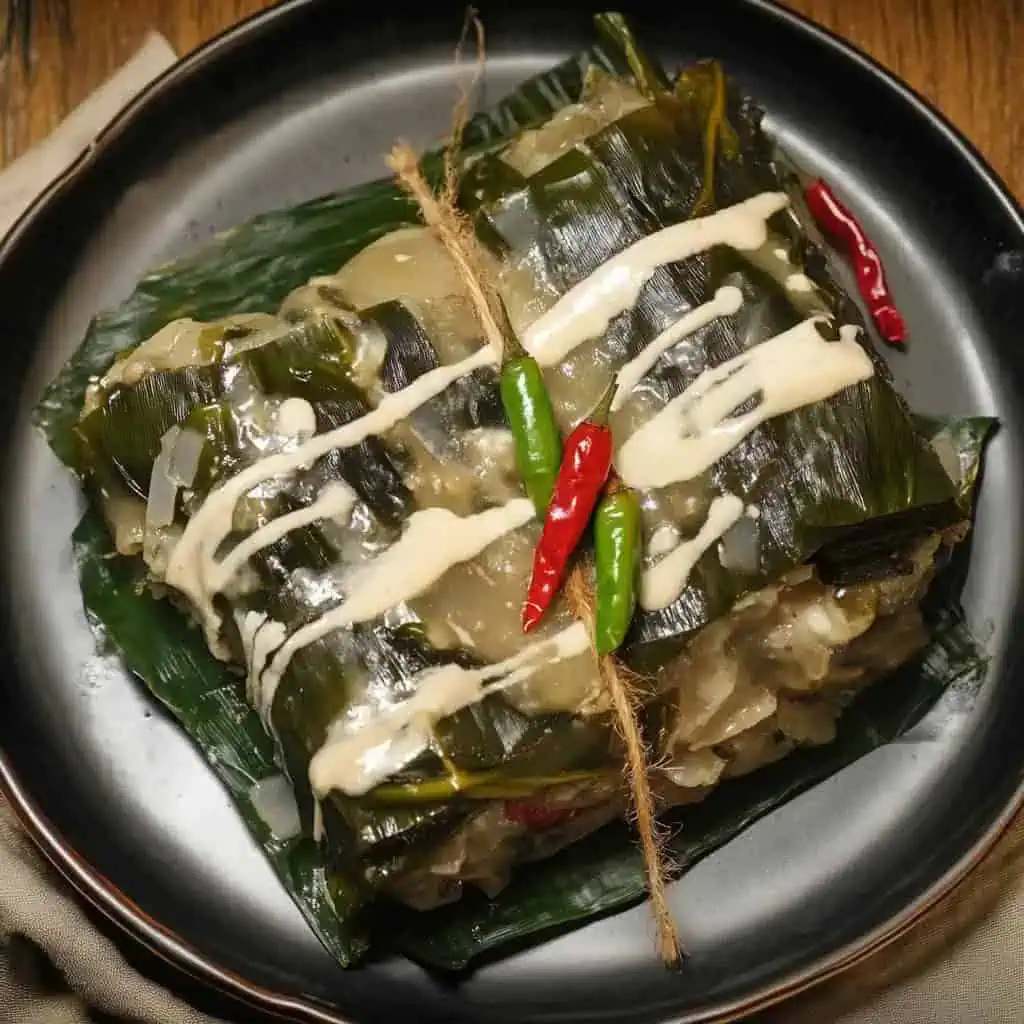
FAQ
Can I make Pinangat ahead for parties?
Yes, you can prepare it up to 24 hours ahead and store in the refrigerator. Reheat by steaming for the best results, which will maintain the moisture and texture.
Why is it important to avoid holes in taro leaves?
Holes in the leaves will cause the filling to leak during cooking, resulting in a messy dish and loss of flavor. The intact leaves also help tenderize properly during cooking.
Is this dish typically very spicy?
The heat level is entirely customizable based on the amount of chilies you use. Traditional Bicolano versions tend to be spicy, but you can adjust according to your preference.
Can I use regular mature coconut instead of young coconut?
Yes, but young coconut (buko) provides a sweeter flavor and softer texture that complements the seafood beautifully. If using mature coconut, increase the cooking time slightly.
How do I know when the Pinangat is fully cooked?
The taro leaves should be very soft and most of the liquid should be absorbed after 45-60 minutes of simmering. You can test by gently pressing a parcel - it should feel tender throughout.
Can I make a vegetarian version?
Absolutely. Substitute the shrimp with chopped mushrooms (shiitake or oyster work well) and add a tablespoon of nutritional yeast or seaweed for umami flavor.
What's the difference between Pinangat and Laing?
While both use taro leaves, Pinangat features whole leaf parcels filled with shrimp and coconut, while Laing uses shredded leaves and dried fish cooked directly in coconut milk.
How do I handle taro leaves safely?
Always use fresh taro leaves and cook them thoroughly. Never consume raw taro leaves as they contain calcium oxalate crystals that can cause irritation.
Related
Looking for other recipes like this? Try these:
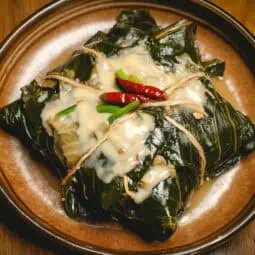
Pinangat ng Bicol (Tilmok, Tinulmok or Tinuktuk)
Equipment
- Large pot with lid (kaldero) for steaming the Pinangat
- Food processor or large knife (panggilingan) for mixing ingredients
- Kitchen twine (Pisi) for securing the leaves
- Heavy-bottom cooking pot (makapal na kaldero) for even heat distribution
- Measuring cups and spoons (Panukat) for precise measurement
- Chopping board (sangkalan)
- Sharp knife (matulis na kutsilyo)
- Grater (kudkuran) for coconut meat
Ingredients
For the Filling:
- ½ kg freshwater shrimp hipon, peeled and seasoned with 1½ tablespoon salt
- 600 g young coconut meat buko, about 5 young coconuts, grated
- 2 onions sibuyas, chopped
- 2 tablespoon grated ginger luya
- 6 cloves garlic bawang
- Chilies siling labuyo to taste
- 20-30 fresh taro leaves dahon ng gabi - must be intact without holes
- Kitchen string
- 6-8 stalks lemongrass tanglad, white portions only, smashed
- 3-4 cups pure coconut milk gata
For the Sauce/Topping:
- 2 cups thick coconut cream kakang gata
- 5 cloves garlic bawang, finely chopped
- 4 shallots sibuyas tagalog, finely chopped
- 2 stalks lemongrass tanglad, white portions sliced
- Salt asin to taste
- 3-5 spring onions dahon ng sibuyas, finely chopped
Instructions
- Start by preparing the filling. Using a food processor or large knife, combine the peeled and salted freshwater shrimp (hipon), grated young coconut meat (buko), chopped onions (sibuyas), grated ginger (luya), garlic (bawang), and chilies (siling labuyo) until the mixture resembles cornmeal texture (parang giniling). Keep this mixture at room temperature while preparing the leaves.
- Carefully inspect fresh taro leaves (dahon ng gabi) to ensure they have no holes or spots, as these can cause leaks during cooking. Lay out overlapping taro leaves in your work area. Place approximately 3 tablespoons of the prepared filling mixture in the center of the leaves. Wrap the leaves carefully around the filling, making sure to seal the edges well, and tie securely with kitchen string (pisi) or use the taro leaf stalks as natural ties.
- Before cooking, prepare your pot by lining the bottom with smashed lemongrass stalks (tanglad). Arrange the wrapped Pinangat packets carefully in the pot, then pour in 3-4 cups of pure coconut milk (gata) until the packets are mostly covered. Bring to a gentle simmer over low heat (160°F/71°C), cover the pot, and cook for 45-60 minutes, occasionally shaking the pot gently to prevent sticking. The Pinangat is done when the leaves are soft and most of the coconut milk has been absorbed.
- While the Pinangat is cooking, prepare the sauce. In a separate pan over medium-low heat (175°F/79°C), combine 2 cups of thick coconut cream (kakang gata) with finely chopped garlic, shallots (sibuyas tagalog), and sliced lemongrass. Simmer until the sauce becomes thick and creamy, then season with salt (asin) to taste. Just before removing from heat, stir in finely chopped spring onions (dahon ng sibuyas).
- Serve the Pinangat hot with steamed white rice (kanin), generously spooning the prepared sauce over each portion. The dish can be stored in an airtight container in the refrigerator for up to 3 days, or frozen for up to 1 month. When reheating, steam for 10-15 minutes or microwave with a damp cloth cover. Remember not to reheat more than once for food safety.
Tips from Lola's Kitchen
- Choose young taro leaves for better wrapping and texture
- Test taro leaves for freshness by checking for holes or spots
- Squeeze coconut cream from fresh coconuts for best results
- Toast grated coconut slightly before mixing for enhanced flavor
- Use banana leaf strips as alternative ties for authentic touch
Nutrition
The Story Behind Pinangat ng Bicol
Deep in the verdant Bicol region, where coconut trees sway endlessly and taro plants flourish in the rich volcanic soil, Pinangat emerged as a testament to Bicolano ingenuity in cooking. This beloved dish, also known as Tilmok, Tinulmok, or Tinuktuk in various Bicolano dialects, showcases the region's abundance of fresh seafood and coconuts, ingredients that have shaped Bicolano cuisine for generations.
Originally created by coastal communities in Bicol, Pinangat was born from the practical need to preserve seafood in the days before refrigeration. The combination of wrapping seafood in taro leaves and cooking it in coconut milk not only preserved the shrimp but transformed these humble ingredients into something extraordinary. The taro leaves, locally known as "gabi," weren't just a wrapper – they became an essential part of the dish, imparting a unique flavor and silky texture as they cooked.
The dish's preparation method reflects the strong influence of pre-colonial Filipino cooking techniques, where wrapping food in leaves was a common practice. This method, known as "pinais" in other regions, reached its pinnacle in Bicol's Pinangat, where the wrap-and-steam technique perfectly married with the region's love for coconut milk and spicy flavors. The use of young coconut meat, rather than just coconut milk, sets Pinangat apart from similar leaf-wrapped dishes across the Philippines.
Today, Pinangat has evolved from a practical preservation method to a celebrated dish that graces Filipino tables during special occasions. While traditionally made with freshwater shrimp, many families have their own versions, passed down through generations, some using crab, fish, or even pure coconut meat. Despite these variations, the essence remains the same – the magical combination of seafood, young coconut, and taro leaves, all brought together in the embrace of rich coconut milk.
What makes Pinangat truly special is its role in Bicolano family gatherings. The process of preparing it often becomes a family affair, with multiple generations working together to wrap and tie each parcel. This tradition of communal cooking has helped preserve not just the recipe but the stories and techniques that make each family's version unique. It's this rich cultural heritage that has earned Pinangat its place as one of the most distinctive dishes in Filipino cuisine.










Comments
No Comments